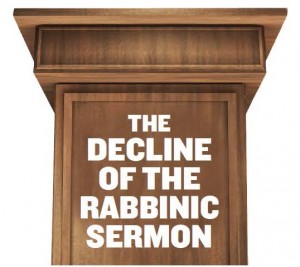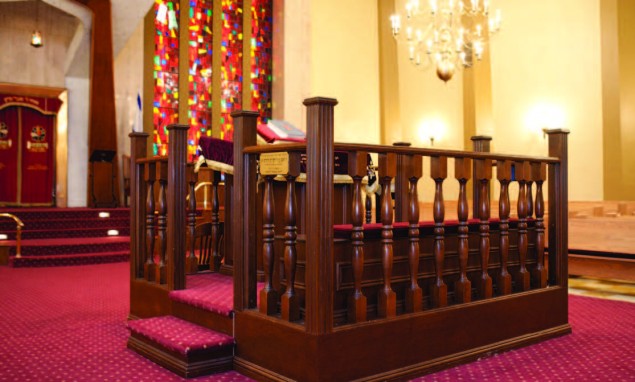The Decline of the Rabbinic Sermon
Many rabbis and lay people took offense at the front page of a recent issue of the Wall Street Journal that explored the culture of “kiddush clubs” in the American Orthodox synagogue. Most likely, their indignation stemmed from the realization that much of what was written is true. My teacher, historian Jonathan Sarna, often called upon to articulate the fashions and trends among America’s Jews, put it like this: “Once upon a time, some people went to synagogue to talk to God. Nowadays, more and more people come to see their friends.” The prayers and sermons, he concluded, “are a distraction. Conviviality goes better with a drink.”1
There are many elements at fault for the hedonism that festers in many American synagogues, a culture that moves congregants to absent themselves from the rabbi’s sermon for a drink. One responsible party is no doubt the rabbi himself. Of late, a scholar of Jewish sermons remarked matter-of-factly that “homiletics is not an art that is especially valued today.” 2 He did not have the Orthodox sermon in mind exclusively, but his evaluation is still very applicable. Both in style and substance, the contemporary Orthodox sermon has lost meaningfulness. How much meaning is open to debate, but its overall decline is apparent. It remains as a Shabbat morning institution not because it is a halachic necessity but because it has grown into an expectation. History provides both criticism and solutions. Seen in its proper context, we might understand that this problem says much about the rabbinate and much more about American Orthodoxy in its present state.
No longer viewed as leaders meant to inspire and instruct, traditional rabbis in America lost their purpose. So did their sermons.
The Orthodox sermon slumped to a nadir many decades ago. On Yom Kippur 1956, Rabbi Solomon Roodman testified that he had “perused the sermons and lectures of yesterday’s preachers” to help him enlighten the worshippers at Congregation Anshei Sfard of Louisville, Kentucky. Most of what he had found in sermon manuals was unhelpful. “I discovered a pessimistic outlook concerning the survival of Orthodoxy in the United States,” he explained.3 Rabbi Roodman surveyed a literature composed by mostly immigrant rabbis. They were very often learned men whose Old World-style Yiddish was embellished with traditional lore and wisdom. Yet, by the interwar years of the twentieth century, their sermons also conveyed unflattering cynicism.
At the outset of that century, congregations hired Yiddish preachers for the same reason that they employed cantors: for entertainment.4 Presentation and showmanship mattered most for many synagogue attendees, especially for those whose religious observance was considerably lacking. Cantors offered the men and women in the pews their parents’ Old World sounds. Rabbis served as entertainers too. Their sermons were full of reproof and rebuke.5 Congregants rarely listened to the sermon’s message, however. Like the liturgy and the music that accompanied the service, the rabbi’s speech became ritualized; it was part of the synagogue performance. An additional part of that theater was an entertainment component. Orthodox rabbis spoke in a “medley of proverbs and tales, and occasional jokes,” said one preacher, who compared his role to a “clown dancing on a rope.” Another rabbi agreed, characterizing his role as “not simply an entertainer but a comedian.”6 No longer viewed as leaders meant to inspire and instruct, traditional rabbis in America lost their purpose. So did their sermons.
Much credit, then, goes to a generation of English-speaking rabbis who invigorated lethargic American Orthodox Jews around midcentury. Their sermons, along with a growing coterie of better-educated young people, rejuvenated a dying community. Those young rabbis of the fifties and sixties learned their craft from the few exemplary Orthodox preachers of the past generation, first and foremost, Rabbi Joseph Lookstein. Starting in the 1930s, he trained hundreds of Orthodox rabbis at Yeshiva University in the art of homiletics. Rabbi Lookstein implored his students to refine their English skills. More like his non-Orthodox counterparts, Rabbi Lookstein embraced contemporary literature and scholarship that helped support his ideas. What separated Rabbi Lookstein from more liberal clergy was that the spirit and substance of his sermons were drawn from the classic sources of Judaism. Also, unlike many of his Orthodox peers, Rabbi Lookstein held a Columbia University doctorate. He used that scholarly training, frequently borrowing from the vocabularies of social scientists when he delivered sermons at his synagogue on New York’s Upper East Side.
Like the liturgy and the music that accompanied the service, the rabbi’s speech became ritualized; it was part of the synagogue performance.
For a variation of that sort of scholarship-filled sermon, an Orthodox Jew might have traveled across Central Park to listen to Rabbi Leo Jung on Manhattan’s West Side make good use of his own doctoral training. For novelist Herman Wouk, Rabbi Jung’s “religious ideas articulated in the light of secular wisdom” elevated the religious commitment of his “Hassidic grandfather” from the realm of “naïve” to “wise.” 7 In any case, Rabbis Lookstein and Jung were two exceptions of the pre-World War II generation that had not yet embraced the English-language sermon.
But they were pioneering models for the subsequent generation. One of Rabbi Lookstein’s students, Rabbi Dr. Norman Lamm, recalled his most “gifted teacher” as “the greatest orator of his generation of rabbis, certainly of the Orthodox rabbinate.”8 If Rabbi Lookstein was the master teacher, then Rabbi Lamm was the master student; he set the standard for his generation of Orthodox preachers. Rabbi Lamm’s recently published sermons, Derashot Ledorot: A Commentary for the Ages, copublished by Yeshiva University and OU Press, reveal his mastery of rabbinic sources, his fondness for the wisdom of Chassidic masters and his wide-ranging knowledge of academic scholarship and popular literature of the time.
Rabbis Lookstein and Jung used labels like “Traditional” or “Torah-True” to identify their brand of American Judaism. Their discourses constantly broached the topics of Americanization and tradition. Yet they stopped short of an attempt to shape the identity of American Orthodoxy by name. Disagreeing with this approach, Rabbi Lamm wrote that the “great problem of modern American Orthodoxy is that it has failed to interpret itself to itself.”9 Whether his peers agreed with him or not, Rabbi Lamm dared to define the American Orthodox cause. Within short order, observers dubbed Rabbi Lamm one of the “most eloquent spokesmen for modern Orthodoxy.”10
Sermons boasting definitions of Orthodox Judaism became less urgent once Orthodox Judaism found its footing in the midcentury. And, perhaps somewhat exhausted with refining the movement, Orthodox preaching redirected its focus. The politics and social movements that enveloped American culture in the 1960s eventually overwhelmed the rabbinic sermons. Crises in Israel and the protest movement on behalf of Soviet Jewry pushed politics to the forefront of the rabbinic agenda.
Many Orthodox Jews appreciated this rhetoric.11 Still, not everyone approved of the political sermon. One layperson derided the new form of sermons as a “weekly exercise in logical acrobatics which attempt to flimsily tie together the rich tapestries of the Torah with the shallow goings-on in the world of politics.”12
By the 1980s, both Soviet Jews and Israel were better politically situated and rabbis began to look for new content to fill their sermons. Some had no idea where to look, however. Already in the final years of the 1970s, one prominent Brooklyn preacher bemoaned the fading rabbinic regard for sermons. “On the eve of Sabbaths and holidays,” he freely admitted, “a number of our colleagues become frantic in search of an idea or a story.” 13
Rabbinic apathy for sermons was an open secret. In 1986, Rabbi Lamm voiced his concern over a new crop of rabbis whose excellence in Torah produced a type of elitism that could not regard the Sabbath sermon “as a serious enterprise worthy of [their] attention.”14 But these young men would come around; they would have to in order to survive in the pulpit, he surmised. Rabbi Lamm predicted that future rabbis would be compelled to transition the Orthodox sermon to a model that could be simultaneously inspiring and satisfy “a new type of congregant” who was “more committed to Torah and especially to Halakhah, and who will take the whole religious enterprise with a great deal of seriousness.”15
Rabbi Lamm’s prophecy has been partially realized. No doubt, the current American Orthodox laity is a more knowledgeable and religiously observant one than the ones of the past. These women and men seek out opportunities beyond the sermon to receive the rigorous Torah education that Rabbi Lamm hoped they would find at the Sabbath pulpit. Many of today’s rabbis, as a result, offer up sermons that too often feature more Eastern European folklore than Torah. That our pulpit rabbis champion so-called “Jewish values” or Shabbat observance is admirable, but hardly inspirational. The combination of knowledgeable congregants and counter-intellectual rabbis is particularly unfortunate given the sophisticated questions—specifically, questions pertaining to technology and gender—that now challenge the contours of American Orthodoxy. True, the humor and rebuke in the rabbis’ sermons are conducted in English rather than in Yiddish. Nonetheless, it is difficult to deny the parallels between the American Orthodox sermons delivered today and a century ago. Long ago, those men begrudgingly accepted their roles as entertainers and comedians. Our generation desires something more. We require leaders.
Rabbi Zev Eleff is a doctoral candidate at Brandeis University. He also teaches Judaic studies at Maimonides School in Brookline, Massachusetts.
Notes
1. Lucette Lagnado, “After These Jewish Prayer Services, Things Come ‘To Life’ at Open Bar,” Wall Street Journal, February 8, 2013.
2. Marc Saperstein, “Is the Sermon on its Deathbed?,” European Judaism 42 (2009): 160.
3. Solomon Roodman, The Vaccine of Faith (New York, 1957), 104.
4. Jeffrey Shandler, “Sanctification of the Brand Name: The Marketing of Cantor Yossele Rosenblatt,” in Chosen Capital: The Jewish Encounter with American Capitalism, ed. Rebecca Kobrin (New Jersey, 2012), 255-71.
5. Kimmy Caplan, Orthodoxy in the New World: Immigrant Rabbis and Preaching in America (1881-1924) (Jerusalem, 2002), 164-79.
6. Quotations derived from and translated by Menahem Blondheim, “Divine Comedy: The Jewish Orthodox Sermon in America 1881-1939,” in Multilingual America: Transnationalism, Ethnicity, and the Languages of American Literature, ed. Werner Sollors (New York, 1998), 200.
7. Herman Wouk, “A Word of Thanks,” in The Leo Jung Jubilee Volume: Essays in His Honor on the Occasion of his Seventieth Birthday, eds. Menahem M. Kasher, Norman Lamm and Leonard Rosenfeld (New York, 1962), 41.
8. Norman Lamm, “Eulogy for Rabbi Joseph H. Lookstein,” in Rabbi Joseph H. Lookstein Memorial Volume, ed. Leo Landman (New York, 1980), 8.
9. Norman Lamm, “Modern Orthodoxy’s Identity Crisis,” Jewish Life (May-June 1969): 5.
10. See James Yaffe, The American Jews (New York, 1968), 133 and Charles S. Liebman, Pressure Without Sanctions: The Influence of World Jewry on Israeli Policy (New Jersey, 1977), 261.
11. Adam S. Ferziger, “‘Outside the Shul’: The American Soviet Jewry Movement and the Rise of Solidarity Orthodoxy, 1964-1986,” Religion and American Culture 22 (winter 2012): 83-130.
12. Jonathan Kellerman, “Striving for Relevance: A Student View,” Jewish Life (March-April 1970): 34.
13. Bernard L. Berzon, Sermons the Year ‘Round: Ninety Sermons Covering all Sidrot, Holidays, and Special Occasions (New York, 1978), 1.
14. Norman Lamm, “Notes of An Unrepentant Darshan,” Sermon Anthology of the Rabbinical Council of America 44 (1986): 2.
15. Ibid., 10-11.


